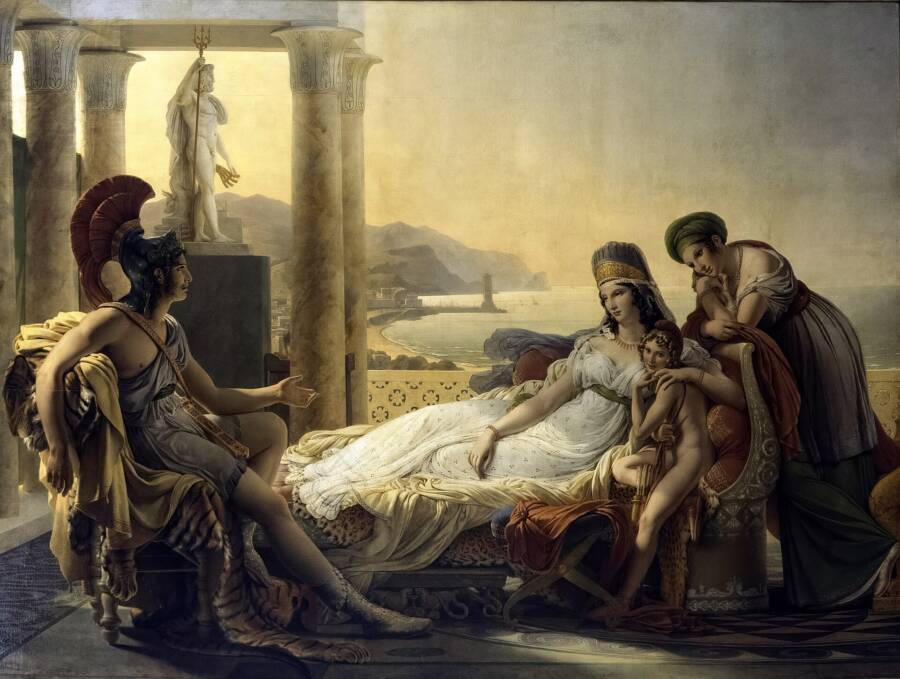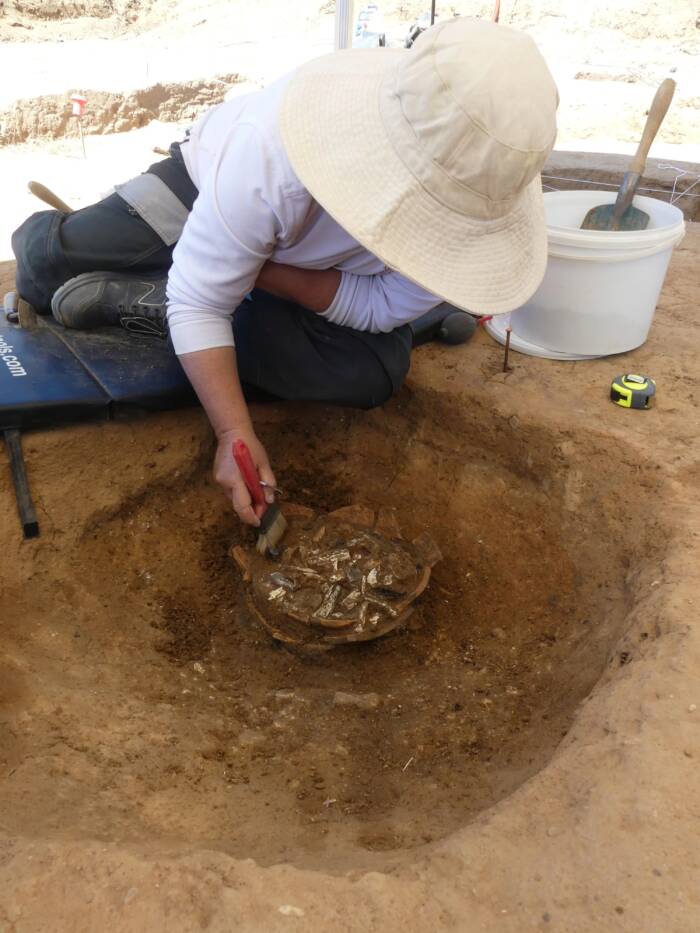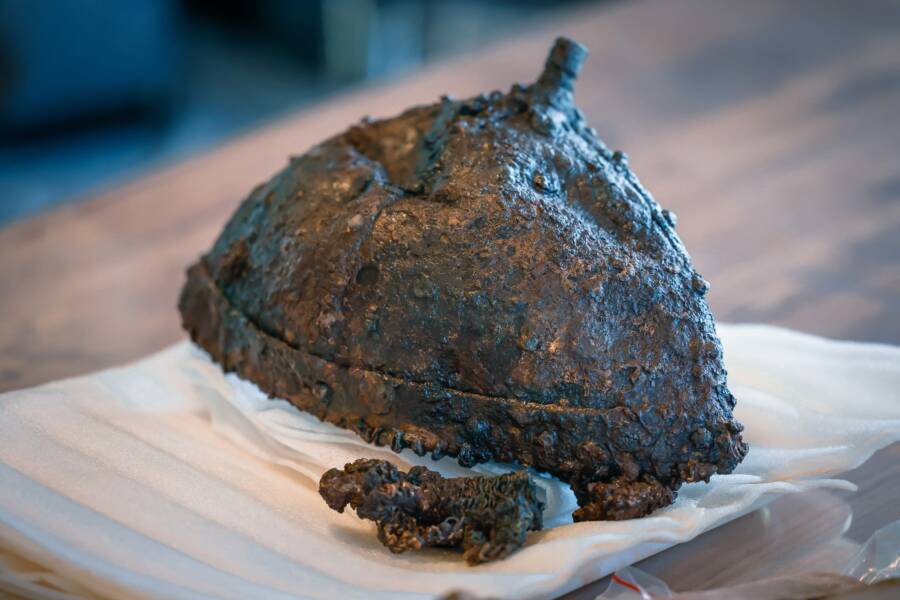0 Комментарии
0 Поделились
693 Просмотры

Каталог
Elevate your Sngine platform to new levels with plugins from YubNub Digital Media!
-
Войдите, чтобы отмечать, делиться и комментировать!
-
3 Ways To Get A Free Turkey This Thanksgiving3 Ways To Get A Free Turkey This Thanksgiving...0 Комментарии 0 Поделились 725 Просмотры
-
 ALLTHATSINTERESTING.COMInside The Ancient Legend Of Dido, The Founder Of Carthage And The Doomed Lover Of AeneasPierre-Narcisse Gurin/Louvre MuseumA painting of Queen Dido and the Trojan hero Aeneas.According to Greco-Roman legend, Dido founded the ancient city of Carthage in modern-day Tunisia by requesting a seemingly small amount of land from a local chieftain only as much as an ox-hide could cover. Dido then cleverly cut that ox-hide into tiny strips and laid them out in a circle, claiming a much larger space than expected.Encompassing an entire hillside, Carthage quickly transformed into a bustling metropolis, and Dido became famous not only as the founder of the city, but also its first queen. However, as ancient myths tell it, her power and influence couldnt protect her from meeting a tragic fate.In Virgils Aeneid, Queen Dido fell in love with the Trojan hero Aeneas after he landed in North Africa. Though it initially seemed like Aeneas returned her feelings, Aeneas was soon commanded by the gods to continue on his planned journey. He then abandoned Dido, leading her to die by suicide.The mists of time have forever clouded the story of this fabled queen, and its still unclear whether she was inspired by a real historical figure. Despite this, Didos legends have captivated countless people for millennia. Who Was Queen Dido Of Carthage?Public DomainA portrait of Queen Dido by Dosso Dossi.The queen of Carthage was known by many names, including Elissa, Elisha, Alashiya, and Dido. Her most famous name was an epithet meaning wanderer, likely due to her journey that led her to founding a new city.According to most versions of her story, she originally hailed from Tyre, located in modern-day Lebanon. She was also the daughter of a king. Her brother Pygmalion, who became the leader of Tyre after the king died, slew Didos husband Sychaeus because he was jealous of Sychaeus wealth.Aware that she was in grave danger, Dido fled Tyre with a group of loyal followers and other settlers, eventually reaching North Africa.Some versions of the story state that she carved out her kingdom of Carthage after using the ox-hide trick when asking the local chieftain Hiarbas for land. In other versions, she simply purchased the land from Hiarbas.Either way, she founded her city, which came to be known as Carthage, inspired by the Phoenician phrase for new town. Carthage soon flourished.In early versions of the Dido myth, the same chieftain who gave her the land relentlessly pursued her hand in marriage. Soon, Dido had enough.Out of respect for her late husband, and to escape an unwanted marriage, Dido built a great funeral pyre. Then, right in front of her subjects, she stabbed herself to death, throwing herself on the crackling flames.Of course, that is just one version of the tale of Dido. Queen Dido In The AeneidNational Trust Collections/Wikimedia CommonsAeneas and Achates approaching the Queen of Carthage, Dido, in a Jacopo Amigoni painting.In the famous Roman poet Virgils Aeneid, Dido plays a key role as the doomed lover of the legendary Trojan hero Aeneas. Aeneas, who was said to be the son of Aphrodite and Anchises, fought bravely for Troy until it eventually fell to the Greeks. Though Troy was doomed, Aeneas was able to escape successfully after learning through a vision or a dream that he was destined to found a great new city overseas. But en route to destiny, Aeneas met Dido.Amidst his many adventures, he shipwrecked off the coast of North Africa near Carthage, which led him to cross paths with the queen. The two eventually fell in love, with some versions of the myth claiming that Dido had been resisting many suitors after the death of her former husband. But when it came to Aeneas, Dido was fatefully struck by Cupids arrow. Unfortunately, their love story was short-lived.Aeneas was soon commanded by the gods, particularly Mercury, to continue on his planned journey. Feeling guilty about being sidetracked during his travels, Aeneas promptly abandoned Dido, leaving her heartbroken.Dido eventually became so depressed that she killed herself. But she used her final moments to yield power one last time cursing the Trojans and setting the stage for the Punic Wars between Carthage and Rome.She said: Let there be no love between our peoples and no treaties Let there be war between the nations and between their sons for ever.Aeneas, meanwhile, fulfilled his destiny by sailing to modern-day Italy and establishing Lavinium, paving the way for Romulus to later found Rome.The Historical Truth About CarthageCleveland Museum of Art/Wikimedia CommonsA 19th-century imagining of Carthage.The truth of Didos very existence is not clear, with no proof that the legendary queen was inspired by a real person from history. Carthage, however, was undoubtedly a real city.Tradition holds that the settlement in modern-day Tunisia was founded by Phoenicians of Tyre in 814 B.C.E. They dubbed their new home New Town.Positioned among low hills, near the freshwater Lake of Tunis and the Strait of Sicily, Carthage quickly grew thanks to its natural resources and its ideal location between the east and west of the classical world.This New Town soon made a name for itself among traders for murex shells, which were used to create a coveted purple dye. Carthage also exploited silver mines in and around the region, which increased its wealth.Wikimedia CommonsA modern-day look at Carthages ruins in Tunisia.All these riches whet Romes appetite. Senator Cato the Elder summed it up simply: Delenda est Carthago. (Carthage must be destroyed.)From the mid-3rd century B.C.E. to the mid-2nd century B.C.E., Carthage and Rome were engaged in the Punic Wars, which ultimately ended with the downfall of Carthage. From there, Rome successfully stretched its influence across the Mediterranean. And the legendary Didos city was left in ashes.Didos Lasting Legacy In Legends And ArtRome eventually rebuilt Carthage, turning it into a city to rival Alexandria or Antioch. The new New Town became a favorite of Roman emperors.Despite the Roman renovation, the specter of Dido lingered. Emperor Nero reportedly splurged on missions to find her supposed hidden treasure, which was rumored to be hoarded in some caverns near Carthage.Though Roman Carthage was eventually destroyed amidst a Vandal raid in the fifth century C.E., a Byzantine invasion in the sixth century, and the citys eventual capture by the Arabs in the eighth century, some ancient ruins like temples and aqueducts still remain at the site to this day.The story of Dido also persists. While shes often portrayed as a tragic figure in literature and artwork, not all depictions focus on her feelings of betrayal and her death by suicide. Some portrayals instead highlight her power.One 16th-century carving portrays Dido as a confident queen, nude and defiant, holding the ox-hide that would lead to Carthages founding.The Cleveland Museum of ArtA famous statue of Dido with an ox-hide curtain.Other depictions showcase her wisdom or her statesmanship.Some 16th-century bronze coins depict Dido in profile on one side, with an illustration of Carthage on the other side. In this case, Queen Dido and her city are inseparable, quite literally two sides of the same coin.National Gallery of Art/Wikimedia CommonsA bronze coin of Dido.Its little wonder why ancient Romans and those who came after them were both fascinated and scandalized by Queen Dido and what she represented. A powerful yet tragic woman whose legend left an unforgettable mark on history, Dido may call to mind other ancient queens whose historicity has been confirmed, such as Cleopatra of Egypt and Boudica of Britain. Though Didos name is currently strongly associated with a famous English singer, her name was actually inspired by the fabled queen.When looking back at the history of Queen Didos legend, its fascinating how some civilizations saw her as someone to fear or pity while others saw an admirable, dynamic monarch with unforgettable wisdom and far-reaching influence. In some ways, Dido and her story may reveal more about the storytellers than about the legendary queen herself.Learn more about Romes fierce female enemies by reading about Zenobia, the warrior queen of the Middle East, and Queen Amanirenas, the one-eyed Nubian royal who resisted Roman rule.The post Inside The Ancient Legend Of Dido, The Founder Of Carthage And The Doomed Lover Of Aeneas appeared first on All That's Interesting.0 Комментарии 0 Поделились 126 Просмотры
ALLTHATSINTERESTING.COMInside The Ancient Legend Of Dido, The Founder Of Carthage And The Doomed Lover Of AeneasPierre-Narcisse Gurin/Louvre MuseumA painting of Queen Dido and the Trojan hero Aeneas.According to Greco-Roman legend, Dido founded the ancient city of Carthage in modern-day Tunisia by requesting a seemingly small amount of land from a local chieftain only as much as an ox-hide could cover. Dido then cleverly cut that ox-hide into tiny strips and laid them out in a circle, claiming a much larger space than expected.Encompassing an entire hillside, Carthage quickly transformed into a bustling metropolis, and Dido became famous not only as the founder of the city, but also its first queen. However, as ancient myths tell it, her power and influence couldnt protect her from meeting a tragic fate.In Virgils Aeneid, Queen Dido fell in love with the Trojan hero Aeneas after he landed in North Africa. Though it initially seemed like Aeneas returned her feelings, Aeneas was soon commanded by the gods to continue on his planned journey. He then abandoned Dido, leading her to die by suicide.The mists of time have forever clouded the story of this fabled queen, and its still unclear whether she was inspired by a real historical figure. Despite this, Didos legends have captivated countless people for millennia. Who Was Queen Dido Of Carthage?Public DomainA portrait of Queen Dido by Dosso Dossi.The queen of Carthage was known by many names, including Elissa, Elisha, Alashiya, and Dido. Her most famous name was an epithet meaning wanderer, likely due to her journey that led her to founding a new city.According to most versions of her story, she originally hailed from Tyre, located in modern-day Lebanon. She was also the daughter of a king. Her brother Pygmalion, who became the leader of Tyre after the king died, slew Didos husband Sychaeus because he was jealous of Sychaeus wealth.Aware that she was in grave danger, Dido fled Tyre with a group of loyal followers and other settlers, eventually reaching North Africa.Some versions of the story state that she carved out her kingdom of Carthage after using the ox-hide trick when asking the local chieftain Hiarbas for land. In other versions, she simply purchased the land from Hiarbas.Either way, she founded her city, which came to be known as Carthage, inspired by the Phoenician phrase for new town. Carthage soon flourished.In early versions of the Dido myth, the same chieftain who gave her the land relentlessly pursued her hand in marriage. Soon, Dido had enough.Out of respect for her late husband, and to escape an unwanted marriage, Dido built a great funeral pyre. Then, right in front of her subjects, she stabbed herself to death, throwing herself on the crackling flames.Of course, that is just one version of the tale of Dido. Queen Dido In The AeneidNational Trust Collections/Wikimedia CommonsAeneas and Achates approaching the Queen of Carthage, Dido, in a Jacopo Amigoni painting.In the famous Roman poet Virgils Aeneid, Dido plays a key role as the doomed lover of the legendary Trojan hero Aeneas. Aeneas, who was said to be the son of Aphrodite and Anchises, fought bravely for Troy until it eventually fell to the Greeks. Though Troy was doomed, Aeneas was able to escape successfully after learning through a vision or a dream that he was destined to found a great new city overseas. But en route to destiny, Aeneas met Dido.Amidst his many adventures, he shipwrecked off the coast of North Africa near Carthage, which led him to cross paths with the queen. The two eventually fell in love, with some versions of the myth claiming that Dido had been resisting many suitors after the death of her former husband. But when it came to Aeneas, Dido was fatefully struck by Cupids arrow. Unfortunately, their love story was short-lived.Aeneas was soon commanded by the gods, particularly Mercury, to continue on his planned journey. Feeling guilty about being sidetracked during his travels, Aeneas promptly abandoned Dido, leaving her heartbroken.Dido eventually became so depressed that she killed herself. But she used her final moments to yield power one last time cursing the Trojans and setting the stage for the Punic Wars between Carthage and Rome.She said: Let there be no love between our peoples and no treaties Let there be war between the nations and between their sons for ever.Aeneas, meanwhile, fulfilled his destiny by sailing to modern-day Italy and establishing Lavinium, paving the way for Romulus to later found Rome.The Historical Truth About CarthageCleveland Museum of Art/Wikimedia CommonsA 19th-century imagining of Carthage.The truth of Didos very existence is not clear, with no proof that the legendary queen was inspired by a real person from history. Carthage, however, was undoubtedly a real city.Tradition holds that the settlement in modern-day Tunisia was founded by Phoenicians of Tyre in 814 B.C.E. They dubbed their new home New Town.Positioned among low hills, near the freshwater Lake of Tunis and the Strait of Sicily, Carthage quickly grew thanks to its natural resources and its ideal location between the east and west of the classical world.This New Town soon made a name for itself among traders for murex shells, which were used to create a coveted purple dye. Carthage also exploited silver mines in and around the region, which increased its wealth.Wikimedia CommonsA modern-day look at Carthages ruins in Tunisia.All these riches whet Romes appetite. Senator Cato the Elder summed it up simply: Delenda est Carthago. (Carthage must be destroyed.)From the mid-3rd century B.C.E. to the mid-2nd century B.C.E., Carthage and Rome were engaged in the Punic Wars, which ultimately ended with the downfall of Carthage. From there, Rome successfully stretched its influence across the Mediterranean. And the legendary Didos city was left in ashes.Didos Lasting Legacy In Legends And ArtRome eventually rebuilt Carthage, turning it into a city to rival Alexandria or Antioch. The new New Town became a favorite of Roman emperors.Despite the Roman renovation, the specter of Dido lingered. Emperor Nero reportedly splurged on missions to find her supposed hidden treasure, which was rumored to be hoarded in some caverns near Carthage.Though Roman Carthage was eventually destroyed amidst a Vandal raid in the fifth century C.E., a Byzantine invasion in the sixth century, and the citys eventual capture by the Arabs in the eighth century, some ancient ruins like temples and aqueducts still remain at the site to this day.The story of Dido also persists. While shes often portrayed as a tragic figure in literature and artwork, not all depictions focus on her feelings of betrayal and her death by suicide. Some portrayals instead highlight her power.One 16th-century carving portrays Dido as a confident queen, nude and defiant, holding the ox-hide that would lead to Carthages founding.The Cleveland Museum of ArtA famous statue of Dido with an ox-hide curtain.Other depictions showcase her wisdom or her statesmanship.Some 16th-century bronze coins depict Dido in profile on one side, with an illustration of Carthage on the other side. In this case, Queen Dido and her city are inseparable, quite literally two sides of the same coin.National Gallery of Art/Wikimedia CommonsA bronze coin of Dido.Its little wonder why ancient Romans and those who came after them were both fascinated and scandalized by Queen Dido and what she represented. A powerful yet tragic woman whose legend left an unforgettable mark on history, Dido may call to mind other ancient queens whose historicity has been confirmed, such as Cleopatra of Egypt and Boudica of Britain. Though Didos name is currently strongly associated with a famous English singer, her name was actually inspired by the fabled queen.When looking back at the history of Queen Didos legend, its fascinating how some civilizations saw her as someone to fear or pity while others saw an admirable, dynamic monarch with unforgettable wisdom and far-reaching influence. In some ways, Dido and her story may reveal more about the storytellers than about the legendary queen herself.Learn more about Romes fierce female enemies by reading about Zenobia, the warrior queen of the Middle East, and Queen Amanirenas, the one-eyed Nubian royal who resisted Roman rule.The post Inside The Ancient Legend Of Dido, The Founder Of Carthage And The Doomed Lover Of Aeneas appeared first on All That's Interesting.0 Комментарии 0 Поделились 126 Просмотры -
 ALLTHATSINTERESTING.COMA Sprawling Ancient Burial Ground Where The Dead Were Ritualistically Cremated Has Been Discovered In Franceric Conrad, InrapThough the dead were burned, archaeologists still found the remnants of their bones.During updates to a road along the French Mediterranean coast, near the ancient settlement of Olbia, archaeologists discovered evidence of an elaborate cemetery dating back to the Roman era. There, they found what remained of funeral pyres and grave goods, as well as an elaborate libation channel used to leave liquid offerings to the dead. The necropolis, which may connect to other former funerary sites in the area, is a remarkable testament to how people in the region mourned their dead.The Ancient Necropolis Of OlbiaAccording to a statement from the National Institute for Preventive Archaeological Research (Inrap), the funerary site near Olbia (in present-day Hyres, France) was detected during excavations ahead of a project to update a nearby road. During these digs, archaeologists found a necropolis stretching across roughly 8,600 square feet that was seemingly used between the first and third centuries C.E.Aurlie Luciani, SDA VarA partially melted bronze object found at the site of an ancient funeral pyre.Archaeologists believe that the site was used solely for cremation. They uncovered pits with reddened walls, seemingly from intense flames. Nails found alongside burned bones suggest that the dead were placed upon funeral pyres, where a central depression in the pits provided ventilation. The deceased were thus seemingly placed on a pyre over a pit with pottery and other important personal belongings to accompany them into the afterlife. The pyre was then set on fire, which reddened the walls of the pit, destroyed the wood, cracked the bones of the corpses, and melted the glass and bronze objects that had been placed alongside them. Some of these pyre sites also included unburned items, which suggested that they were used as burial pits once the fire died down. However, other pits were seemingly emptied, and the cremated remains were moved to another location. These pits were graves sometimes marked with a sandstone block. And in the final resting place of the dead, mourners seemingly left objects like glass perfume bottles and vases in their tombs.Sylvie Duchesne, InrapAn example of a pyre that was transformed into a tomb, complete with a roof.But the ritual of mourning the dead didnt end here. How The Dead Were Mourned In Ancient OlbiaAfter the ritual of burning and burying the dead was complete, ancient people in Olbia seemingly turned next to pleasing the deities. To do so, they left behind items like perfume, coins, and lamps. But one of the most curious parts of the Olbia necropolis is a libation conduit. According to Inrap, this distinctive feature of the necropolis was seemingly installed above the graves. Here, mourners could leave liquid offerings, including wine, beer, and mead. Tassadit Abdelli, InrapTwo libation conduits which were placed atop graves, and where mourners could pour liquids like beer and wine in a gesture to the deities. These conduits, made from amphorae seemingly obtained through maritime trade, were possibly used to ensure the protection of the deceased in the afterlife. Alternatively, these liquid offerings may have been a way for mourners to honor the dead.In any case, the necropolis found at Olbia seems to be one of many that once stretched along the French Mediterranean coast. Other burial areas were detected nearby in 2022 and 2023, thus suggesting that an even larger area dedicated to the deceased existed in Roman times along a coastal road likely leading towards the city of Toulon/Telo Martius.Such discoveries are a fascinating look at the people who once lived in the area. According to Inrap, Olbia was a fortified colony founded in the fourth century B.C.E., and it was occupied until the sixth century C.E. Its citizens clearly had elaborate methods of honoring the dead, which archaeologists are still untangling. As Inrap noted in their statement, These discoveries remind us that ancient funerary rites were rich, varied, and imbued with multiple meanings, some of which remain mysterious even today.After reading about the sprawling ancient necropolis where cremations once took place along the French Mediterranean coast, discover the fascinating story of Naours, France, one of the worlds most incredible underground cities. Or, enjoy these stunning photos from Frances La Belle poque. The post A Sprawling Ancient Burial Ground Where The Dead Were Ritualistically Cremated Has Been Discovered In France appeared first on All That's Interesting.0 Комментарии 0 Поделились 128 Просмотры
ALLTHATSINTERESTING.COMA Sprawling Ancient Burial Ground Where The Dead Were Ritualistically Cremated Has Been Discovered In Franceric Conrad, InrapThough the dead were burned, archaeologists still found the remnants of their bones.During updates to a road along the French Mediterranean coast, near the ancient settlement of Olbia, archaeologists discovered evidence of an elaborate cemetery dating back to the Roman era. There, they found what remained of funeral pyres and grave goods, as well as an elaborate libation channel used to leave liquid offerings to the dead. The necropolis, which may connect to other former funerary sites in the area, is a remarkable testament to how people in the region mourned their dead.The Ancient Necropolis Of OlbiaAccording to a statement from the National Institute for Preventive Archaeological Research (Inrap), the funerary site near Olbia (in present-day Hyres, France) was detected during excavations ahead of a project to update a nearby road. During these digs, archaeologists found a necropolis stretching across roughly 8,600 square feet that was seemingly used between the first and third centuries C.E.Aurlie Luciani, SDA VarA partially melted bronze object found at the site of an ancient funeral pyre.Archaeologists believe that the site was used solely for cremation. They uncovered pits with reddened walls, seemingly from intense flames. Nails found alongside burned bones suggest that the dead were placed upon funeral pyres, where a central depression in the pits provided ventilation. The deceased were thus seemingly placed on a pyre over a pit with pottery and other important personal belongings to accompany them into the afterlife. The pyre was then set on fire, which reddened the walls of the pit, destroyed the wood, cracked the bones of the corpses, and melted the glass and bronze objects that had been placed alongside them. Some of these pyre sites also included unburned items, which suggested that they were used as burial pits once the fire died down. However, other pits were seemingly emptied, and the cremated remains were moved to another location. These pits were graves sometimes marked with a sandstone block. And in the final resting place of the dead, mourners seemingly left objects like glass perfume bottles and vases in their tombs.Sylvie Duchesne, InrapAn example of a pyre that was transformed into a tomb, complete with a roof.But the ritual of mourning the dead didnt end here. How The Dead Were Mourned In Ancient OlbiaAfter the ritual of burning and burying the dead was complete, ancient people in Olbia seemingly turned next to pleasing the deities. To do so, they left behind items like perfume, coins, and lamps. But one of the most curious parts of the Olbia necropolis is a libation conduit. According to Inrap, this distinctive feature of the necropolis was seemingly installed above the graves. Here, mourners could leave liquid offerings, including wine, beer, and mead. Tassadit Abdelli, InrapTwo libation conduits which were placed atop graves, and where mourners could pour liquids like beer and wine in a gesture to the deities. These conduits, made from amphorae seemingly obtained through maritime trade, were possibly used to ensure the protection of the deceased in the afterlife. Alternatively, these liquid offerings may have been a way for mourners to honor the dead.In any case, the necropolis found at Olbia seems to be one of many that once stretched along the French Mediterranean coast. Other burial areas were detected nearby in 2022 and 2023, thus suggesting that an even larger area dedicated to the deceased existed in Roman times along a coastal road likely leading towards the city of Toulon/Telo Martius.Such discoveries are a fascinating look at the people who once lived in the area. According to Inrap, Olbia was a fortified colony founded in the fourth century B.C.E., and it was occupied until the sixth century C.E. Its citizens clearly had elaborate methods of honoring the dead, which archaeologists are still untangling. As Inrap noted in their statement, These discoveries remind us that ancient funerary rites were rich, varied, and imbued with multiple meanings, some of which remain mysterious even today.After reading about the sprawling ancient necropolis where cremations once took place along the French Mediterranean coast, discover the fascinating story of Naours, France, one of the worlds most incredible underground cities. Or, enjoy these stunning photos from Frances La Belle poque. The post A Sprawling Ancient Burial Ground Where The Dead Were Ritualistically Cremated Has Been Discovered In France appeared first on All That's Interesting.0 Комментарии 0 Поделились 128 Просмотры -
 ALLTHATSINTERESTING.COMArchaeologists In Georgia Discover A Helmet And Chainmail That Are At Least 1,000 Years OldRustavi History Museum/FacebookThe medieval helmet is remarkably intact and includes a facial guard.Archaeologists have uncovered a rare medieval helmet and chainmail shirt at Rustavi Fortress in the country of Georgia. The historic items date back to the ninth or 10th century, and theyre incredibly well preserved for their age. Theyre also the only known armor artifacts of their kind to be found in the South Caucasus region. Both the helmet and chainmail shirt were unearthed at Rustavi Fortress, which is one of the oldest fortresses in the region, dating back to the Middle Bronze Age. The most recent finds at the site have begun to fill a crucial gap in the archaeological record, as very few pieces of medieval armor have been found throughout the Caucasus, especially in such great condition.The Historic Discovery Of Medieval Armor At Rustavi FortressRustavi History Museum/FacebookAn archaeologist looks over the chainmail shirt found near the helmet at the fortress.Both artifacts were found during excavations of the Rustavi Fortress sixth chamber, which officially started in July 2025. The project was originally set up to investigate the palace complex within the historic fortress that dates between the ninth and 12th centuries.Many objects have been uncovered during the ongoing excavation, but the helmet and chainmail shirt are especially remarkable.The helmet is made of iron and still contains its facial muzzle guard. The design may have been influenced by Byzantine or Persian helmets. Likewise, the chainmail shirt was in good enough condition for archaeologists to quickly identify that it was made out of interconnected metal rings. Both items date to the ninth or 10th century. Since the pieces of armor showed signs of advanced craftsmanship, its believed that they belonged to an elite soldier or even a commander who was stationed at Rustavi Fortress. And because the discovery is the first of its kind in the area, it helps fill a crucial gap in the archaeological record.Both the helmet and chainmail shirt are pieces of direct evidence that show how armor and warfare evolved during the medieval era in Georgia, and how that technology was potentially impacted by Arab, Byzantine, and more local influences. Preliminary examination suggests that the metal in both items couldve been produced locally, meaning that there was a high level of craftsmanship and technical skill in the area.The Incredible History Of Rustavi FortressRustavi History Museum/FacebookExcavations at Rustavi Fortress are ongoing.Rustavi Fortress has an extensive history in the country of Georgia. The structure sits about 15 miles southeast of Tbilisi, and was first occupied starting in the Middle Bronze Age.Its believed to be one of the earliest settlements in the ancient Kingdom of Iberia. It also underwent three separate reconstruction phases, the first phase lasting from the fifth to eighth century, the second lasting from the ninth to 11th century, and the third lasting from the 12th to 13th century.The recent excavations that began at Rustavi Fortress in July are ongoing, and experts are hoping to uncover more priceless artifacts. Over 100 archaeologists, university students, and volunteers are involved in the digs.The city of Rustavi eventually wants to make Rustavi Fortress an open-air museum, which would allow for the public to view in-progress archaeological excavations. Currently, the helmet and chainmail shirt are undergoing conservation processes. Once those processes are complete, officials plan to put the items on display at the Rustavi Museum. After reading about the rare medieval helmet and chainmail shirt found in Georgia, learn about the remains of an ancient warrior woman uncovered in Armenia. Then, take a look at an ancient Greek satyr mask found in the ruins of the Greek city of Phanagoria.The post Archaeologists In Georgia Discover A Helmet And Chainmail That Are At Least 1,000 Years Old appeared first on All That's Interesting.0 Комментарии 0 Поделились 116 Просмотры
ALLTHATSINTERESTING.COMArchaeologists In Georgia Discover A Helmet And Chainmail That Are At Least 1,000 Years OldRustavi History Museum/FacebookThe medieval helmet is remarkably intact and includes a facial guard.Archaeologists have uncovered a rare medieval helmet and chainmail shirt at Rustavi Fortress in the country of Georgia. The historic items date back to the ninth or 10th century, and theyre incredibly well preserved for their age. Theyre also the only known armor artifacts of their kind to be found in the South Caucasus region. Both the helmet and chainmail shirt were unearthed at Rustavi Fortress, which is one of the oldest fortresses in the region, dating back to the Middle Bronze Age. The most recent finds at the site have begun to fill a crucial gap in the archaeological record, as very few pieces of medieval armor have been found throughout the Caucasus, especially in such great condition.The Historic Discovery Of Medieval Armor At Rustavi FortressRustavi History Museum/FacebookAn archaeologist looks over the chainmail shirt found near the helmet at the fortress.Both artifacts were found during excavations of the Rustavi Fortress sixth chamber, which officially started in July 2025. The project was originally set up to investigate the palace complex within the historic fortress that dates between the ninth and 12th centuries.Many objects have been uncovered during the ongoing excavation, but the helmet and chainmail shirt are especially remarkable.The helmet is made of iron and still contains its facial muzzle guard. The design may have been influenced by Byzantine or Persian helmets. Likewise, the chainmail shirt was in good enough condition for archaeologists to quickly identify that it was made out of interconnected metal rings. Both items date to the ninth or 10th century. Since the pieces of armor showed signs of advanced craftsmanship, its believed that they belonged to an elite soldier or even a commander who was stationed at Rustavi Fortress. And because the discovery is the first of its kind in the area, it helps fill a crucial gap in the archaeological record.Both the helmet and chainmail shirt are pieces of direct evidence that show how armor and warfare evolved during the medieval era in Georgia, and how that technology was potentially impacted by Arab, Byzantine, and more local influences. Preliminary examination suggests that the metal in both items couldve been produced locally, meaning that there was a high level of craftsmanship and technical skill in the area.The Incredible History Of Rustavi FortressRustavi History Museum/FacebookExcavations at Rustavi Fortress are ongoing.Rustavi Fortress has an extensive history in the country of Georgia. The structure sits about 15 miles southeast of Tbilisi, and was first occupied starting in the Middle Bronze Age.Its believed to be one of the earliest settlements in the ancient Kingdom of Iberia. It also underwent three separate reconstruction phases, the first phase lasting from the fifth to eighth century, the second lasting from the ninth to 11th century, and the third lasting from the 12th to 13th century.The recent excavations that began at Rustavi Fortress in July are ongoing, and experts are hoping to uncover more priceless artifacts. Over 100 archaeologists, university students, and volunteers are involved in the digs.The city of Rustavi eventually wants to make Rustavi Fortress an open-air museum, which would allow for the public to view in-progress archaeological excavations. Currently, the helmet and chainmail shirt are undergoing conservation processes. Once those processes are complete, officials plan to put the items on display at the Rustavi Museum. After reading about the rare medieval helmet and chainmail shirt found in Georgia, learn about the remains of an ancient warrior woman uncovered in Armenia. Then, take a look at an ancient Greek satyr mask found in the ruins of the Greek city of Phanagoria.The post Archaeologists In Georgia Discover A Helmet And Chainmail That Are At Least 1,000 Years Old appeared first on All That's Interesting.0 Комментарии 0 Поделились 116 Просмотры -
 WWW.MASHED.COMThe Vintage Barn-Shaped Burger Chain That Took Over America Then DisappearedAt one point this vintage burger chain had 400 locations going strong. Turns out there are still fans online hoping it will someday make a comeback.0 Комментарии 0 Поделились 113 Просмотры
WWW.MASHED.COMThe Vintage Barn-Shaped Burger Chain That Took Over America Then DisappearedAt one point this vintage burger chain had 400 locations going strong. Turns out there are still fans online hoping it will someday make a comeback.0 Комментарии 0 Поделились 113 Просмотры -
 WWW.MASHED.COM3 Ways To Get A Free Turkey This ThanksgivingWith inflation and other economic troubles hitting hard, food insecurity is on the rise. Here are some free options to still have a turkey for Thanksgiving.0 Комментарии 0 Поделились 114 Просмотры
WWW.MASHED.COM3 Ways To Get A Free Turkey This ThanksgivingWith inflation and other economic troubles hitting hard, food insecurity is on the rise. Here are some free options to still have a turkey for Thanksgiving.0 Комментарии 0 Поделились 114 Просмотры -
 TECHCRUNCH.COMa16z pauses its famed TxO Fund for underserved founders, lays off staffAndreessen Horowitz is pausing its Talent x Opportunity(TxO)fundand program,according tomultiple sources.0 Комментарии 0 Поделились 96 Просмотры
TECHCRUNCH.COMa16z pauses its famed TxO Fund for underserved founders, lays off staffAndreessen Horowitz is pausing its Talent x Opportunity(TxO)fundand program,according tomultiple sources.0 Комментарии 0 Поделились 96 Просмотры -
Bottled Air Market: Segment Outlook Highlighting Product and Application Growth AreasThe bottled air market is rapidly evolving as awareness of air pollution and its harmful effects on health continues to grow worldwide. Once viewed as a novelty, bottled air has become a serious wellness commodity, particularly in countries where air quality deterioration poses a major public health concern. With demand rising from consumers, wellness centers, and tourism operators,...0 Комментарии 0 Поделились 1Кб Просмотры
-
 YUBNUB.NEWSTrump Supercharges SAVE Program to Stop Illegals from VotingPresident Donald Trumps administration is rolling out major upgrades to the Systematic Alien Verification for Entitlements (SAVE) program, aiming to protect the integrity of U.S. elections by preventing0 Комментарии 0 Поделились 96 Просмотры
YUBNUB.NEWSTrump Supercharges SAVE Program to Stop Illegals from VotingPresident Donald Trumps administration is rolling out major upgrades to the Systematic Alien Verification for Entitlements (SAVE) program, aiming to protect the integrity of U.S. elections by preventing0 Комментарии 0 Поделились 96 Просмотры


